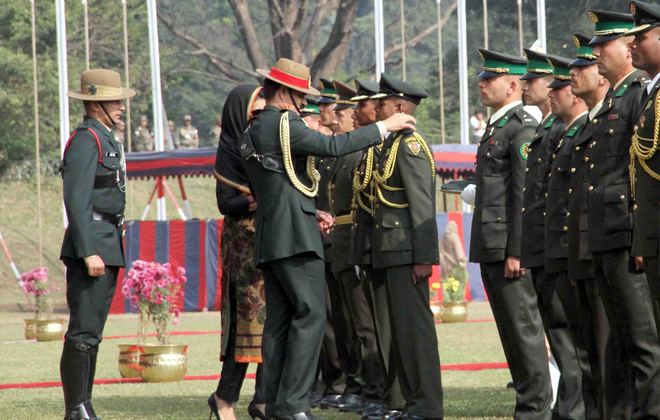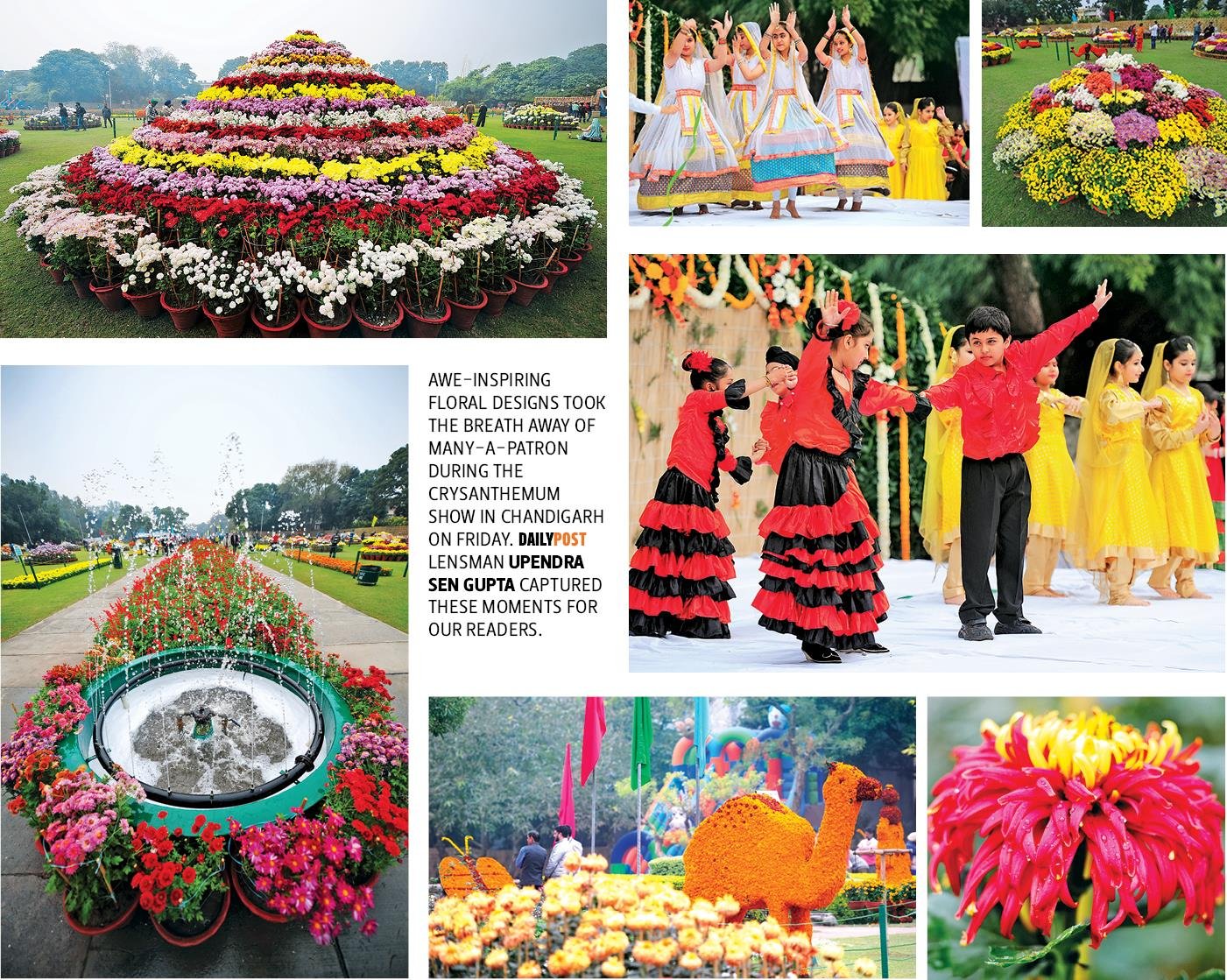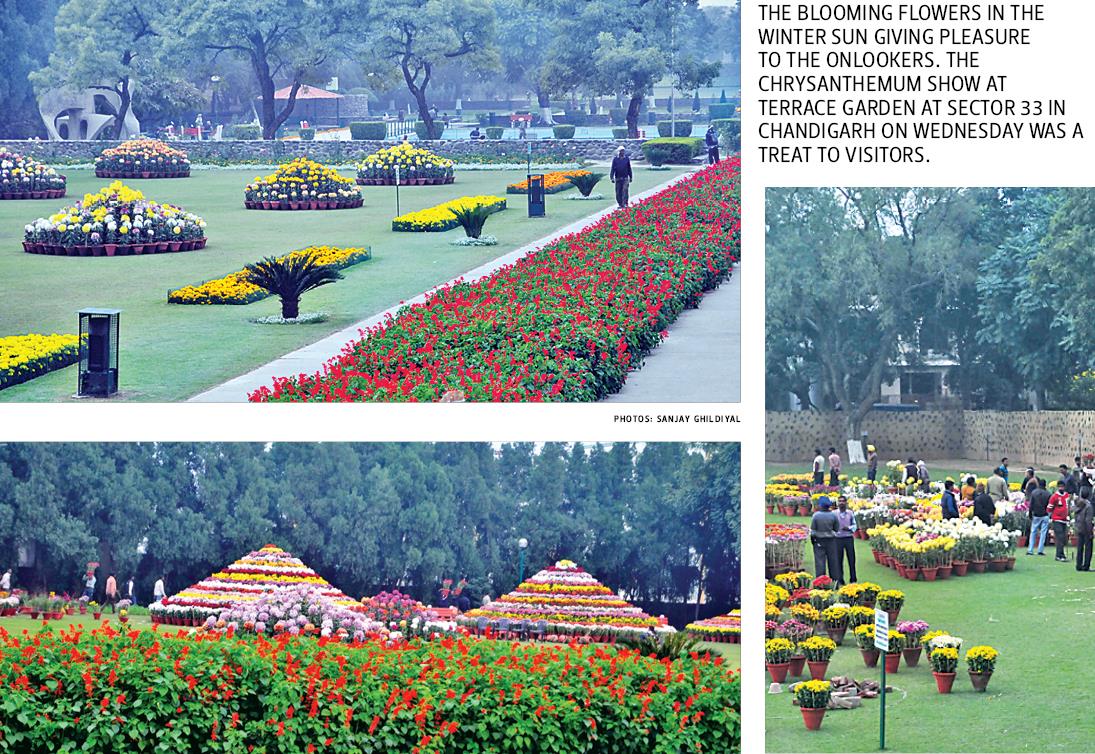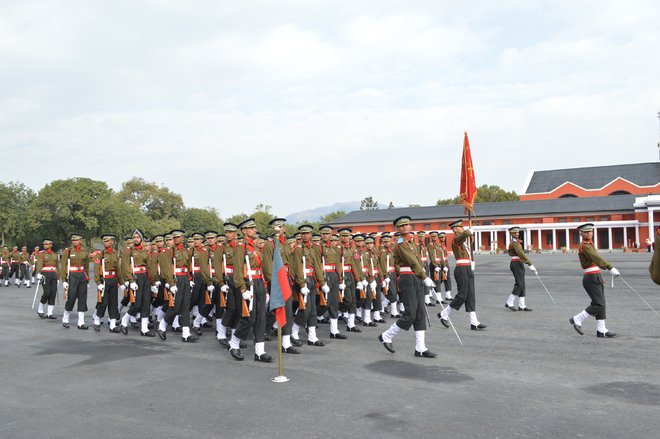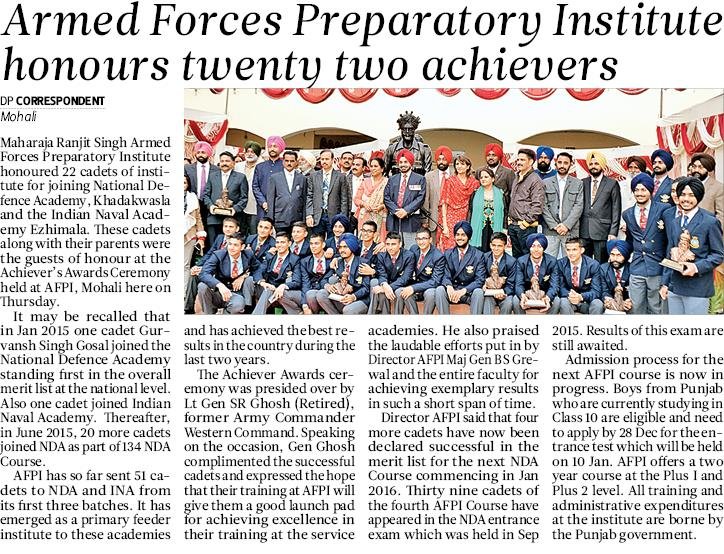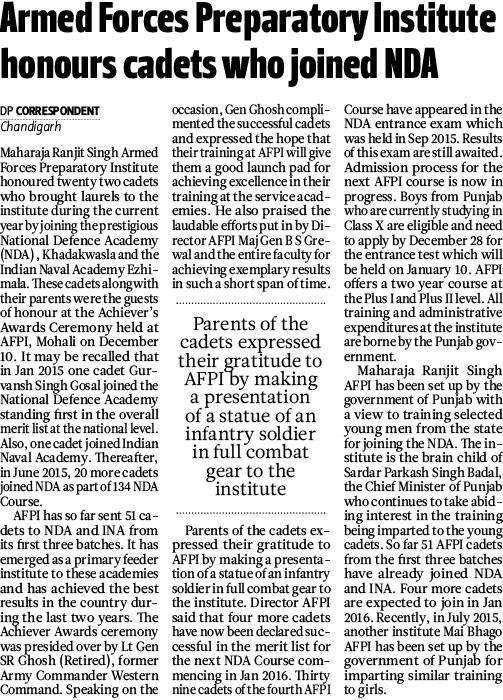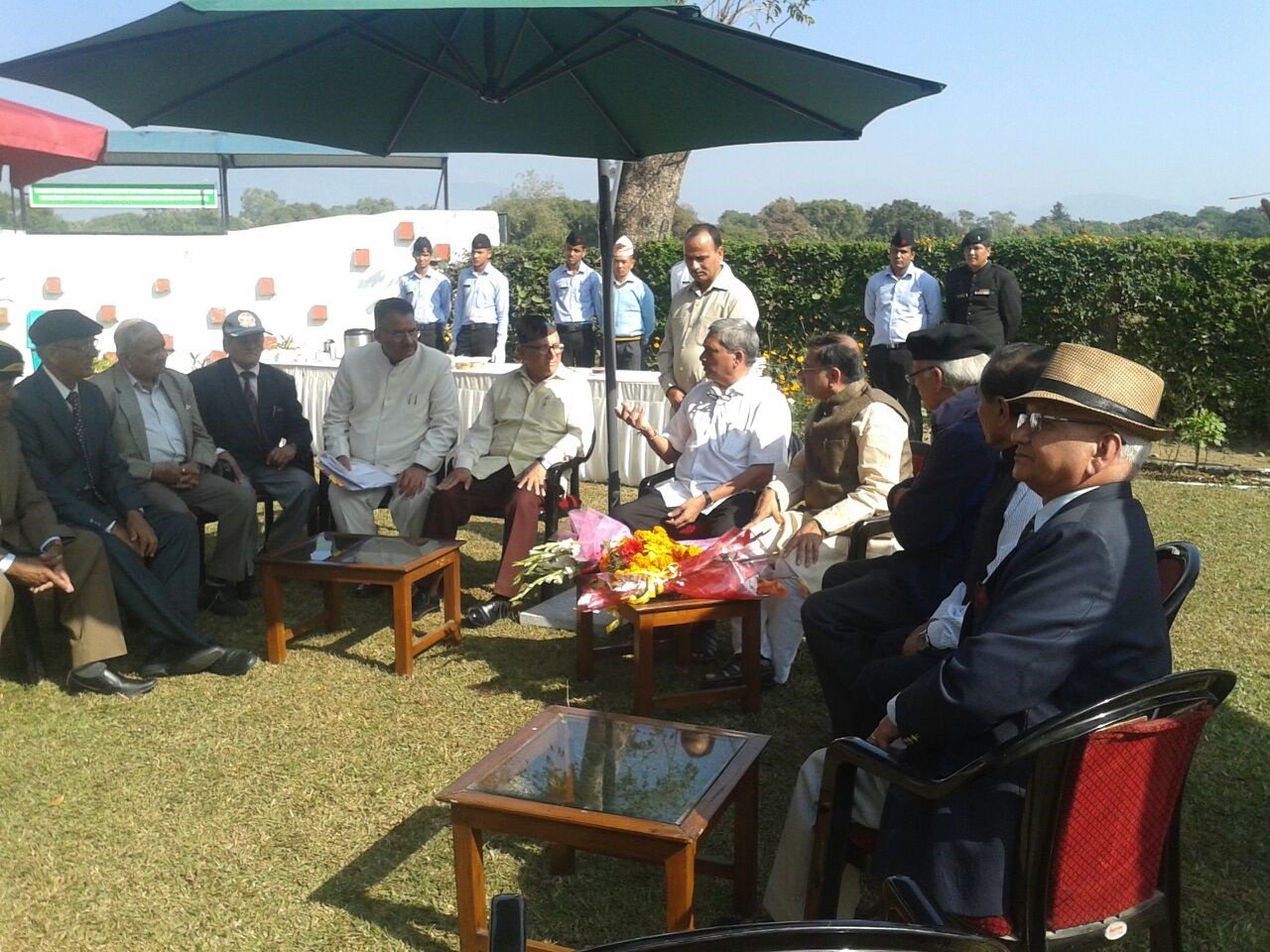Please see trailing reports by Committee of Secretaries constituted under Cabinet Secretary in 2009 & 2012. These are now in Public Domain through RTI; thanks to the efforts of Air Marshal SY Savur. Some observations:
There has been a constant endeavor to improve scales of OR & JCOs; so much so that the latter are already on OROP – a statement that i have been making over the last several months.
All along there have been consultations with Government recognized ESM Organisations (IESL, Air Force Association & DIWAVE) and their inputs considered.
There has been no support for OROP – in fact all reasons including legal have been given for its non-implementation. To that extent we have come a long way
Even The Supreme Court (in judgment dated 29.1.1991) took the view that the petitioners’ claim that all pre-1.4.1979 retirees of the Armed Forces are entitled to the same amount of pension as available to post 1.4.79 retirees was clearly untenable and did not flow from the Nakara decision – so much for those who talk of going to Supreme Court on OROP; we have no case unless final letter/tables are out and there are anomalies/ creation of a class within a class
Brig Vijay Raheja
09810631945
Report of the Committee
On
One Rank One Pension & Related Issues
30th June 2009
[Received on 03 Dec 2015 vide MoD letter No. 237/RTI/D (P/P)/2014 dated 30 Nov 2015 alongwith Cabinet Secretary Committee (CSC) report 2012.
Please note: Hereafter any bold print is from the Report]
1.1. On a reference from the Raksha Mantri regarding the issue of ‘One Rank One Pension,’ the Prime Minister had directed that the proposal of Raksha Mantri on ‘One Rank One Pension’ be examined by a Committee headed by the Cabinet Secretary with Defence Secretary, Home Secretary, Secretary DOPT, Secretary (Expenditure) and Secretary (Ex-Servicemens Welfare) as Members. Secretary, Doo Pensions & PW was co-opted as a Member of the Committee. The Committee held 5 meetings to consider the matter.
1.2. In this context, the President, in her address in Parliament on June 4, 2009 also announced that the Committee headed by the Cabinet Secretary to look into the issue of ‘One Rank One Pension’ has already commenced work and expects to complete it by the end of June, 2009.
The issue of ‘One Rank One Pension’
2.1. Ex-Servicemen Associations have been demanding the grant of ‘One Rank One Pension’ for many years. ‘One Rank One Pension’ implies that uniform pension be paid to the Armed Forces personnel retiring in the same rank with the same length of service irrespective of their date of retirement and any future enhancement in the rates of pension be automatically passed onto to past pensioners.
2.2. The demand for grant of ‘One Rank One Pension’ has been considered by the Government a number of times in the past. The Estimates Committee (1980-81) on resettlement of ex-servicemen noted that disparity in pension between past and present pensioners of Equal rank was inequitable and recommended that the matter should be examined and a just solution found to end this disparity. Thereafter, this issue was raised in 1984 by the High Level Empowered Committee on the problems of ex-servicemen headed by Shri K P Singh Deo, the then Minister of State for Defence. This Committee recommended that the Fourth CPC may consider the issue particularly in the light of the principle established regarding pensions of Judges of the Supreme Court and High Court.
2.3. The Fourth Pay Commission considered the issue and stated that the amount of pension undergoes changes as and when pay scales are revised and any attempt to equalise pension with reference to the revised scales of pay would amount to retrospective application of pay scales.
2.4. Subsequently, a High Level Empowered Committee chaired by the then Defence Minister, Shri Sharad Pawar, was formed in 1991 to consider the matter. This Committee did not recommend grant of ‘One Rank One Pension.’ However, this Committee observed that the terms and conditions of service of Armed Forces were distinct and as such, a special dispensation for them was required. Based on this, grant of a One Time Increase (OTI) was recommended and granted on the following lines:
(a) Sepoy Pensioners
(i) Grant of benefit of 18 years service to all retiring on or after 1.1.1986.
(ii) Pre and Post 1.1.1973 retirees brought at par and stepped up by neutralising 95% differential between post 1.1.86 and post 1.1.73 rates of pension.
(b) NCOs/JCOs/Honorary Commissioned Officers – Pension of post 1.1.1986 retirees reduced in a graded manner by R 10/- pm for 15 years of service and by additional Rs 2/- p.m. for additional years of service up to 24 years of service. The difference between existing pension and revised pension so arrived at was rounded off to the lower multiple of Rs 5/- and granted as OTI.
(c) Officers
(i) Pre 1.1.1973 pension stepped up to post 1.1.1973 level.
Officers below Colonel
(ii) Pension further raised by giving benefit of 33 years as the system of weightage was only started from 1.1.1973. The revised consolidated pension (RCP) was thereafter determined with reference to improved original pension and difference between this RCP and existing pension granted as One Time Increase.
2.5. The Fifth Pay Commission, on the matter of grant of full parity in pensions of Defence personnel, stated that while they agreed that the gap between past and future pensioners should be narrowed down, it was pertinent to note that every Pay Commission gives certain benefits in pay which are over and above the impact of inflation. The additional benefit is given either due to upgradation of recruitment qualifications or change in job content etc. The benefit accrued on this account need not necessarily be passed on to pensioners. Keeping these factors in view and taking a cue from the Sharad Pawar Committee, the Fifth CPC made the following recommendations for Armed Forces personnel:
(i) In the case of Commissioned Officers, total parity may be brought between pre- 1.1.1986 and post 1.1.1986 retirees by notional fixation of pay in the post 1.1.1986 scales and the notional revised pension be worked out on the basis of this pay. Thereafter, for all pre-1.1.1996 retirees the fitment formula suggested for past civilian pensioners i.e. Basic Pension + Dearness Relief + Interim Relief 1 (Rs 50) + Interim Relief 2 (10% of Basic Pension) + 20% (revised by Government to 40%) of Basic Pension, may be applied. If the resultant figure falls short of the minimum pension applicable to the post 1.1.96 retirees for the rank held, it may be stepped up to the minimum pension prescribed for the rank.
(ii) In the case of PBORs, the need for notional fixation of pay does not exist in view of the existence of pension tables. Therefore, for PBOR all pre-1.1.1986 pensioners may be brought on pensioners may be brought onto the post 1.1.1986 levels by bridging the present gap in the pension tables and the same fitment formula on pension as for officers may be applied. If the resultant figure falls short of the minimum pension for the rank and group for post-1.1.1996 retiree, it may be upgraded to that level.
2.6. After the Fifth Pay Commission, an Inter-Ministerial Committee was set up in 2003 by the Department of Pension & Pensioners’ Welfare to consider the demand of ‘One Rank One Pension.’ The Committee in its report submitted on 24.9.2004 did not favour grant of ‘One Rank One Pension’ but recommended grant of modified parity based on the maximum of the revised scale of pay introduced with effect from 1.1.1996 for PBOR.
2.7. Ministry of Finance did not agree with the proposal of the Ministry of Defence for implementation of the recommendations of the Committee. They observed that any departure from the principle laid down by the 5th CPC regarding modified parity, would be introduction (through a side door), of the one rank one pension system and the same should not be further modified to redress presumed injustice. The position was brought to the notice of (the) Prime Minister who directed that a Group of Ministers be constituted to consider the demand of one rank one pension.
2.8. Accordingly, a Group of Ministers (GOM) was constituted by the Government in January 2005 to look into the issue. After detailed deliberations on various aspects, the GOM felt that One Rank One Pension cannot be agreed to. However, there was justification for improving the pensionary benefits of the Personnel Below Officer Rank (PBOR), particularly the three lowest ranks.
2.9. Finally, the GOM unanimously recommended that the pension of pre-1.1.1996 PBOR retirees may be revised with reference to maximum of post 1.1.1996 pay scales. In addition, the weightage of Sepoy, Naik and Havildar rank for past as well as future retirees be increased to 10, 8 and 6 years respectively subject to a maximum of qualifying service of 30 years. The benefit was given only for service pension. The benefit of the above recommendation took effect from 1.1.2006.
2.10. The Sixth Pay Commission, on the issue of ‘One Rank One Pension’ for Defence personnel, stated as under: –
“One Rank One Pension has been demanded for all ex-servicemen. The Fifth CPC had already granted full parity between pre and post 1/1/1986 pensioners and modified parity between pre and post 1/1/1996 pensioners. Identical dispensation was given to the civilian employees as well as Defence Forces personnel. No change is proposed in the existing dispensation either in case of civilians or Defence Forces. Hence, extant provisions may continue.”
2.11. In the context of One Rank One Pension, it is also relevant to mention that a petition was filed by (Indian) Ex-Services League (1991 1 SCR 158) as a sequel to the decision of (the) Supreme Court in D. S. Nakara & Ors Vs Union of India. The relief claimed by petitioners, in substance, was to the effect that the result of the decision in Nakara is that all retirees who held the same rank irrespective of their date of retirement must get the same amount of pension and this should be the amount which was calculated and shown in the appendices to the Memorandum challenged in the Nakara judgment.
The Supreme Court (in judgement dated 29.1.1991) took the view that the petitioners’ claim that all pre-1.4.1979 retirees of the Armed Forces are entitled to the same amount of pension as available to post 1.4.79 retirees was clearly untenable and did not flow from the Nakara decision.
2.12. The issue of ‘One Rank One Pension’ was also referred to the Ministry of law & Justice by Ministry of Defence to advise the Group of Ministers in 2005. The Ministry of Law opined that “the issue has come up for consideration before the Supreme Court in a number of cases wherein the ex-servicemen has not been found to be entitled to one rank one pension under the existing legal regime. This is equally true to the pensions for civil side as well. The cases of K L Rathee Vs UoI 1997 (3) SLR 207 and Indian Ex-Services league and others Vs UoI 1991 1 SCR 158 may be referred to. The issue involves serious implications that need to be duly examined. The pensioners constitute a class and the Supreme Court has said that there cannot be mini-classification in the category. Nonetheless, it must be noted that (the) group is not a homogenous one. The pensioners as a group consist of persons with different number of years service and different average pay during the relevant period. If all of them have to be treated alike by providing same pension while ignoring their respective variations in length in service and average pay, that may amount to treating unequals as equals. This my entail discrimination offending the principles of equality before law as enshrined in our Constitution. Thus, even in case of one rank one pension, there would be large number of persons likely to be affected adversely. The present system has stood the test of judicial scrutiny. The same cannot be said for one rank one pension and the legal feasibility of the same stands open to be adjudicated.”
2.13. On a subsequent reference made in 2008, Ministry of Law advised again that the same pension for same rank was not an acceptable proposition and that no new facts had been brought on record which may necessitate review of their earlier opinion.
2.14. It is also pertinent to mention that in a D. O. reference from the Raksha Mantri to the Finance Minister dated 13th March 2009, the proposal made in relation to One Rank One Pension was as under: –
“While acceptance of the demand for grant of ‘One Rank One Pension’ is not feasible administratively, a strong case definitely exists for bringing the quantum of pension or pre-1.1.1996/10.10.1997 pensioners at par with post 1.1.1996/10.10.1997 and pre 1.1.1996 pensioners as the gap between the pension of the past and the present retirees has widened after implementation of the recommendations of the Sixth CPC. Financially, this would be feasible as it is broadly estimated to entail additional financial burden only to the extent of around Rs 500 crore per annum and would be much less than the estimated financial liability for grant of ‘One Rank One Pension.’ The Ex-Servicemen have also raised certain anomalies in the implementation of the Sixth CPC award which has adversely affected them.”
2.15. Apart from the above factors, grant of ‘One Rank One Pension’ cannot be implemented for ex-servicemen alone and a demand for similar dispensation for civilian pensioners would also arise. The dispensation would then have to be extended to pensioners in autonomous bodies, Central and State Universities and Colleges and in all other institutions where the pension scheme is applicable. The financial implications for such a dispensation would then be substantial.
3. In view of the factors mentioned above, it is not considered feasible to grant ‘One Rank One Pension’ for the following reasons: –
(i) Various Committees have considered the matter in the past and not found enough justification for grant of ‘One Rank One Pension.’
(ii) Successive Pay Commissions have addressed the issue of ‘One Rank One Pension’ in the past and have not recommended it. Pay Commissions are expert bodies which look at pay and pension related issues in a holistic manner keeping all considerations in view.
(iii) Acceptance of the principle of ‘One Rank One Pension’ has substantial financial implications estimated at Rs 8000-9000 crore per annum.
(iv) Revision of pay scales at times is accompanied with revision of educational qualifications/restructuring of cadres/duties attached to the post etc the benefit of which need not be passed on to past pensioners.
(v) The Supreme Court on the issue of grant of ‘One Rank One Pension’ has ruled in the matter of Indian Ex-Services League Vs UOI AIR 1991 SC 1182 examined the issue of ‘One Rank One Pension’ and held that the claim for ‘One Rank One Pension’ is not tenable. The apex court in the decision of K L Rathee Vs UOI 1997 (3) AISLJ 207 held that the claim for same pension for same rank cannot be accepted.
(vi) Ministry of Law, which was consulted, has also opined that the same pension for same rank is not an acceptable proposition.
(vii) The matter was also considered by a Group of Ministers in 2005-06 and this Group did not recommend grant of ‘One Rank One Pension,’ although certain improvements in the scheme of modified parity were recommended and accepted by the Government.
Issues pertaining to Personnel Below Officer Rank (PBOR)
4.1. Although the Ministry of Defence did not recommend grant of ‘One Rank One Pension’ to the PBORs, certain improvements in the pension structure of PBORs were suggested to the Committee. It was brought out by MoD that at present there are 4 classes of PBOR pensioners: –
(i) Those who retired prior to 10.10.1997: – For those who retired prior to 10.10.1997, pension is being computed with reference to the maximum of emoluments arrived at in the scale of pay applicable after 1.1.1996. This pension is with reference to 5 trade groups of PBORs namely, A to E (pre 1.1.1996) and 4 trade groups post 1.1.1996/
(ii) Those who retired between 10.10.1997 and 31.12.2005: – With effect from 10.10.97, the trade groups were rationalised and PBORs in service distributed into 3 trade groups X, Y and Z. Pay scales of PBORs were also improved at this stage. Therefore, for post 10.10.1997 PBORs retirees, pension was computed with reference to maximum of the pay scale for X, Y, and Z groups introduced w.e.f 10.10.1997. This pension was higher than pension granted to pre-10.10.1997 retirees.
(iii) & (iv) Those who retired between 1.1.2006 and 31.8.2008 and Those who retired on or after 1.9.2008: – There is a distinction between the pensions of the PBORs who retired between 1.1.2006 and 31.8.2008 and those who retired on or after 1.9.2008 on account of the treatment of Classification allowance for grant of pension. Classification allowance, which is also an element of reckonable emoluments has not been revised w.e.f 1.1.2006 but w.e.f 1.9.2008 and pre-revised rates of this allowance are admissible till 31.8.2008. Accordingly, pension admissible to those retired between 1.1.2006 and 31.8.2008 is less than pension admissible to post 1.9.2008 retirees.
Pension of PBORs who retired prior to 10.10.1997
4.2. In order to achieve to some extent the objective of One Rank One Pension, MoD has proposed that the higher pension applicable to post 10.10.1997 PBOR pensioners may also be granted to the pre-10.10.1997 pensioners. The financial implications of this proposal have been estimated at Rs 470.688 crore per annum by MoD.
4.3. The Committee considered the proposal and concluded that if the proposal of the Ministry of Defence is accepted, it would, to some extent, take care of grievance of ex-servicemen and would also place all pre-1.1.2006 pensioners in the same class. Further, the financial implications of the proposal are manageable and the scheme does not have repercussions on civilian employees. The Committee, therefore, recommends that this proposal of MoD be accepted.
Pension of PBORs who retired after 1.1.2006
4.4. Classification allowance was granted to PBORs in the Army on attaining certain trade related qualifications in each group. Prior to 6th CPC, 50% of the Classification Allowance was reckoned for pension. The 6th Pay Commission double the rates of Classification Allowance and also extended it to the Navy & Air Force. The Pay Commission also recommended that the entire Classification Allowance may be reckoned for calculation of pension. The revised rates were made applicable w.e.f 1.9.2008 (date from which all other allowances were revised). Consequently, pension admissible to those retiring between 1.1.2006 and 31.8.2008 is less than the pension of post 1.9.2008 retiree PBORs. The financial implications on this account have been estimated at Rs 7.73 crore per annum.
4.5. Since it does not seem to have been the intention of the Pay Commission to create two classes of PBOR pensioners after 1.1.2006, the Committee recommends that the proposal of MoD regarding reckoning of the revised rate of classification allowance from 1.1.2006 could be agreed to. As in the case of Military Service Pay, the revised rate of classification allowance will be reckoned notionally w.e.f 1.1.06 for calculation of pension.
Further Improvements in Pension of pre-1.1.2006 PBORs
5.1. While the above two proposals would meet to some extent the demands of ex-servicemen, the Committee felt that the major issue of bridging the gap between past and current pensioners was not being addressed adequately by these two recommendations. The Committee also interacted with various Ex-Servicemen Associations, namely Indian Ex-Services League, the Air Force Association and the Disabled War Veterans (India) to seek their views in the matter. During the course of this interaction, the Associations gave the following major options in regard to One Rank One Pension: –
Option 1: Calculation of the pension of pre-1.1.2006 retirees by reckoning the highest of the pay in the pay band for each rank and thereafter application of weightage to this figure.
Option 2: Calculation of pension pre-1.1.2006 retirees by taking the mid-point between the minimum fitment of each rank in the revised pay band and maximum of the pay band and thereafter applying the weightage.
Option 3: Calculation of pension of pre-1.1.2006 retirees with reference to notional maximum in the post 1.1.2006 pay scales. Thereafter, the weightage may be applied.
The options 1 & 2 suggested above are not feasible as even the pension of post 1.1.2006 retirees is not calculated on this basis. However option 3 is similar to the benefit granted in 2006 based on the recommendations of the Group of Ministers.
The Committee also looked at various other options to further improve the pension of PBORs. After detailed examination, the Committee felt that the best method to improve the pension of pre-1.1.2006 pensioners was by using the suggestion mentioned at option 3 above i.e. to follow the principle of the GOM award of 2006. This GOM had granted the following: –
(a) Calculation of pension or pre-1.1.1996 retirees with reference to maximum of post 1.1.1996 pay scales,
(b) Increase in weightage for Sepoy, Naik a Havildar ranks for past and future retirees from 5 years to 10, 8 and 6 years respectively.
5.2. The Committee recommends that the Award of GOM of 2006 may be continued in the following manner: –
(a) To reckon the pension of all pre1.1.2006 PBOR pensioners with reference to notional maximum in the post 1.1.2006 revised pay structure corresponding to the maximum of pre-Sixth Pay Commission pay scales as per fitment table of each rank.
(b) Also to continue with the enhanced weightages awarded by the GOM.
5.3. Annual financial implications on account of this improvement will come to Rs 1636 crore.
5.4. The above dispensation will result in the improvement of pensions of all pre-1.1.2006 PBOR pensioners, as their pension will be reckoned with reference to the notional maximum of the post 1.1.2006 pay scales of each rank as per fitment tables. This benefit has been confined to PBOR pensioners due to the following reasons: –
(i) The GOM Award of 2006 has covered only PBOR pensioners.
(ii) PBORs have generally been treated like a separate class and their pension has been calculated with reference to the maximum of the pay scale. The pension formula for Commissioned Officers is the same as that applicable to civilian employees and any dispensation for Commissioned Officers will generate demands from civilian employees.
(iii) In view of the fact that Lt Colonels and above have been placed in Pay Band – 4, the pension of pre 1.1.2006 Commissioned Officers has already been enhanced substantially. This issue has been discussed in detail in this Report in the portion related to Commissioned Officers.
(iv) Even in the case of post 1.1.2006 PBOR retirees, the Ministry of Defence has been advised by the Finance Ministry to allow them an option of drawing either 50% of the pay last drawn [i.e pay in the pay band + grade pay + X group pay, where applicable, + MSP + classification allowance] as pension or to draw pension based on the post 1.1.2006 pay structure as per fitment table of each rank corresponding to the maximum of Fifth CPC pay scales applying weightage thereafter.
Issues pertaining to Commissioned Officers
6.1. As already brought out, civilian employees are granted pension @ 50% of their last pay drawn/last 10 months average emoluments, whichever is beneficial. Till the Sixth CPC, pension of a civilian employee was reckoned on the basis of the average of his emoluments for the ten months immediately preceding his retirement. The same formula was applied in the case of Defence Forces officers as well (sic). After Sixth CPC, either the pay last drawn or 10 months average, whichever is beneficial is applied in both cases. In the case of Commissioned Officers, however, MSP is taken into account for determination of pension.
Pension of Commissioned Officers who have retired after 1.1.2006
6.2. MoD has brought out that an additional category of Commissioned Officers has got created as the linkage of 33 years of qualifying service to earn full pension has been done away with only in respect of post 1.9.08 retirees. Consequently, the pensioners who retired between 1.1.2006 and 31.8.08 are drawing less pension as compared to post 1.9.08 retirees. MoD has proposed that the concept of removal of linkage of 33 years of qualifying service to earn full pension may be uniformly made applicable w.e.f 1.1.06 itself so that disparity in pension between these two categories is removed.
6.3. It may be brought out here that the Sixth Pay Commission in para 6.5.3 had specifically recommended that this provision will take effect only prospectively for all government employees other than PBORs in Defence Forces from the date it is accepted by the Government. It is for this reason that delinking of full pension from 33 years of qualifying service for Commissioned Officers has been done w.e.f 1.9.2008. A similar provision has also been applied in the case of civilian employees. However, the MoD has calculated the implications on this account as Rs 4.83 crore per annum. The implication on the civilian employees are not likely to be significant as very few civilian employees opt for voluntary retirement before completing 28 years of service.
6.4. The Committee recommends that the MoD’s proposal may be agreed to. This will also have to be applied to civilians since the formula for pension for Commissioned Officers and civilians is the same.
6.5. Financial implications for implementing this proposal are Rs 4.83 crore per annum approximately.
Pension of Commissioned Officers who retired prior to 1.1.2006
6.6. The formula for calculation of pension of Commissioned Officers and for civilian employees is the same. Based on Sixth CPC’s recommendations modified parity has been granted to pre-1.1.2006 civilians/Commissioned Officers by first consolidating the pension as on 1.1.2006 by adding a fitment benefit of 40% of basic pension. If the consolidated figure is less than 50% of the minimum of the pay band + grade pay, the pension is to be stepped up to this amount. In the case of Commissioned Officers, this stepping up is done with reference to 50% of minimum of pay band + grade pay + MSP of Rs 6000. Also, the Government has approved reckoning of MSP for calculating pensions of retired Lt Generals and Major Generals, which enhanced their pensions by Rs 3000 in each case.
6.7. While processing the Report of Sixth CPC, the Committee of Secretaries had separate interactions with senior officers of the three Defence Forces and the three Services Chiefs. Improvement in the pay scale (and consequently the pension) of officers who retired particularly in the rank of Brigadier and Colonel as well as Major General and Lt General was demanded by the three Services after the implementation of the Sixth CPC. Modifying the recommendations of the Pay Commission, the Government placed serving Brigadiers and Colonels in PB-4 and enhanced their grade pay. As a result, the pension of pre 1.1.2006 Commissioned Officers who retired as Brigadiers and Colonels also improved substantially. Subsequently, Lt Colonels were also placed in PB4 and granted enhanced Grade Pay of Rs 8000. This also resulted in increased pension to pre 1.1.2006 retired Lt Colonels as per the modified parity given by 6th CPC from Rs 14, 100 to Rs 25, 700.
6.8. After the implementation of Sixth CPC’s recommendations, the pension of pre 1.1.2006 Brigadiers, Colonels and Lt Colonels have greatly improved and in percentage terms there is very little difference between the pension of pre 1.1.2006 pensioners based on modified parity granted by the Pay Commission and that with reference to minimum of fitment tables. This difference is around 2% at the level of Lt Colonel, 6% at the level of Colonel, 11% at the level of Brigadier, 13% at the level of Major General. Only at the level of Lieutenant Generals is there a substantial difference of about 26%. As a result of modified parity granted by Sixth CPC, the minimum pension assured to retired Lt Generals is Rs 27, 700 (37400+12000+6000/2).
6.9. In order to improve the pension of retired Lt Generals, it is proposed that a separate pay scale may be carved out for officers of the level of Lt Generals. The same will have to be extended to Additional Secretaries/Chief Commissioners (Income Tax & Customs)/Additional DGs of Police/equivalent civilian officers, since both have always had the same pay scale. In the case of HAG+ scale also, while the Sixth CPC had recommended their placement in PB-4 with grade pay of Rs 13000, the Government carved out a separate scale of Rs 75000-80000. The proposed pay scale may start at Rs 67000 and as at present end at Rs 79000. This will enable pre 1.1.06 Lt Generals a pension of Rs 38500 and equivalent civilians a pension of Rs 33500. This solution would take care of their grievances relating to both pay and pension.
6.10. Financial implications for implementing this proposal are Rs 25 crore per annum.
Disability Pension
7.1. As already mentioned, the Committee met representatives of some Ex-Servicemen’s Associations. The following demands were raised in regard to disability pension during discussions held with these Associations: –
1. Broad-banding of percentage of disability/war injury pension for pre 1.1.1996 pensioners.
2. Removal of cap on war injury element of pension.
3. Grant of service element based on full service to war disabled.
4. Grant of disability pension to pre 1.1.06 pensioners on percentage basis instead of slab basis.
7.2. The Committee considered the four issues and its views on them ad seratim are as under: –
1. Prior to 5th CPC, Disability pension was granted on actual percentage of disability. As per 5th CPC recommendations, disability percentage was broad-banded into three slabs for post 1.1.1996 cases only: –
S No. Percentage of disability Rounded off to
(a) Less than 50% 50%
(b) 50% and above but up to 75% 75%
(c) 76% to 100% 100%
The Committee is of the view that this broad-banding can be extended to pre 1.1.1996 cases also.
2. War disabled get service element of pension and a separate war injury element. Service element is calculated by counting service up to date of normal retirement in the rank. War injury element is equal to reckonable emoluments last drawn for 100% disablement. However, a stipulation has been made that the aggregate of service element and war injury element is being restricted to 50% of emoluments, therefore denying the full benefit of war injury element. This is applicable to all Category E disability pensioners which includes disability arising As a result of enemy action in international war, border skirmishes, accidental explosion of mines, extremist acts etc. The Committee recommends that this cap could be considered for removal recognising Category E as a separate class. The number of cases is not likely to be very large. This would also be applicable to similarly placed civilians including Central Para Military Forces (CPMFs).
3. Grant of service element based on full service is already an existing provision and requires no change.
4. Grant of disability pension on percentage basis is a new dispensation applicable only to those disabled after 1.1.06. This demand would need further examination in consultation with D/0 ESW so as to assess the financial and other implications.
SUMMARY OF RECOMMENDATIONS
8. To sum up, the following recommendations are made by the Committee: –
Personnel Below Officer Ranks
(i) The proposal of Ministry of defence to bring pre 10.10.1997 PBOR pensioners on par with post 10.10.1997 PBOR pensioners may be agreed to. Since this is a new concession aimed at improving the pension of PBORs, the benefit will be given prospectively and no arrears are to be given. The financial implications for the proposal would be Rs 470.66 crore per annum.
(ii) The proposal of the Ministry of Defence to reckon the enhanced rate of classification allowance w.e.f.1.1.2006 on notional basis for the purpose of calculation of pension (as in the case of reckoning MSP for determination of pension) may be agreed to. This recommendation would benefit around 88, 000 PBORs who retired between 1.1.2006 and 31.8.2008. The average increase in pension of these PBORs is estimated to be Rs 60 p.m. in Basic Pension. The financial implications for this proposal will be Rs 7.73 crore per annum. This proposal emanates from Sixth CPC’s recommendations and may be implemented w.e.f 1.1.2006. Accordingly, arrears will be paid.
(iii) In order to reduce the gap between the pensions of pre and post 1.1.2006 PBOR pensioners, its is proposed to follow the principle of the Award of GOM of 2006 in the following manner: –
(a) To reckon the pension of all pre 1.1.2006 PBOR pensioners with reference to a notional maximum in the post 1.1.2006 revised pay structure corresponding to the maximum of pre-Sixth Pay Commission pay scales as per fitment table of each rank.
(b) Also to continue with enhanced weightage awarded by the GOM.
This dispensation, which will be applicable to service pension as in the case of GOM award of 2006, will result in average monthly increase in pension of pre 1.1.2006 PBORs in the range of Rs 800 to Rs 1400 for Group Y depending on the rank and years of service. This will benefit approximately 12 lakh pre-1.1.2006 PBOR pensioners. The financial implications on account of this proposal would be Rs 1636 crore per annum. Since this is a new concession aimed at improving the pension of PBORs, the benefit will be given prospectively and no arrears are to be given.
Commissioned Officers
(iv) The proposal to remove the linkage of full pension with 33 years of qualifying service w.e.f 1.1.2006 instead of 1.9.2008 in the case of Commissioned Officers may be agreed to. A similar dispensation will have to be extended to civilians who have retired between 1.1.2006 and 31.8.2008. This recommendation would benefit around 1100 Officers (Army) whose pension would increase by about Rs 3000 p.m. In the case of civilians, this dispensation will benefit only those who have taken voluntary retirement after rendering 20 to 28 years of service. The number of such personnel is not likely to be significant. The financial implications for this proposal will be Rs 4.83 crore per annum. This proposal emanates from Sixth CPC’s recommendations and may be implemented w.e.f 1.1.2006. Accordingly, arrears will be paid.
(v) In order to address the issue of disparity in the pension of pre and post 1.1.2006 pensioners at the level of Lt General/equivalent/Additional Secretary & equivalent civilian categories, a separate pay scale starting at Rs 67000 and going up to Rs 79000 may be created and all officers of the level of Lt General/Additional Secretaries/equivalents may be fixed in this scale. As a result of this, the pension of pre 1.1.2006 Lt Generals will get fixed at Rs 36500 and those of Additional Secretaries at Rs 33500. This will benefit roughly 4000 officers. The financial implication for this proposal will be Rs 25 crore per annum. The proposal emanates from Sixth CPC’s recommendations and may be implemented w.e.f 1.1.2006. Accordingly, arrears will be paid.
All Defence Pensioners
(vi) It is proposed to agree to broad-banding of percentages of disability/war injury pension for pre-1.1.1996 disability/war injury pensioners. The financial implications of the proposal will be collated by Department of Expenditure from Department of Ex-Servicemen Welfare, Department of Pensions and Ministry of Home Affairs.
(vii) It is proposed to remove the cap on war injury element of pension in the case of disabled pensioners belonging to Category E. This will also be applicable to civilian personnel, including those belonging to Central Para Military Forces. The financial implications of the proposal will be collated by Department of Expenditure from Department of Ex-Servicemen Welfare, Department of Pensions and Ministry of Home Affairs.
9. The financial implications of the above proposals from (i) to (v) at a glance are as under: –
Sl No. Proposal Annual Implications
(crore)
(a) Inclusion of classification allowance for PBORs from 1.1.2006 7.73
(b) Removal of linkage of full pension with 33 years from 1.1.2006 4.83
(c) Revision of Lt General pension after carving out a separate pay scale for them 25
(d) Bringing parity between pension of pre and post 10.10.1997 PBOR pensnioers 470.66
(e) Further improving PBOR pensions based on award of GOM 2006 1636
Total 2144.22
Financial implication on account of arrears of (a), (b) and (c) = Rs 164.5 crore
Sd/——————– Sd/—————-
Neelam Nath Rahul Sarin
Secretary (Ex-Servicemen Welfare) Secretary, DOPT
Sd/——————— Sd/—————–
Rajni Razdan Sushama Nath
Secretary (Pension & PW) Secretary (Expenditure)
Sd/———————– Sd/—————–
Madhukar Gupta Vijay Singh
Home Secretary Defence Secretary
Sd/——————
K M Chandrasekhar
Cabinet Secretary





